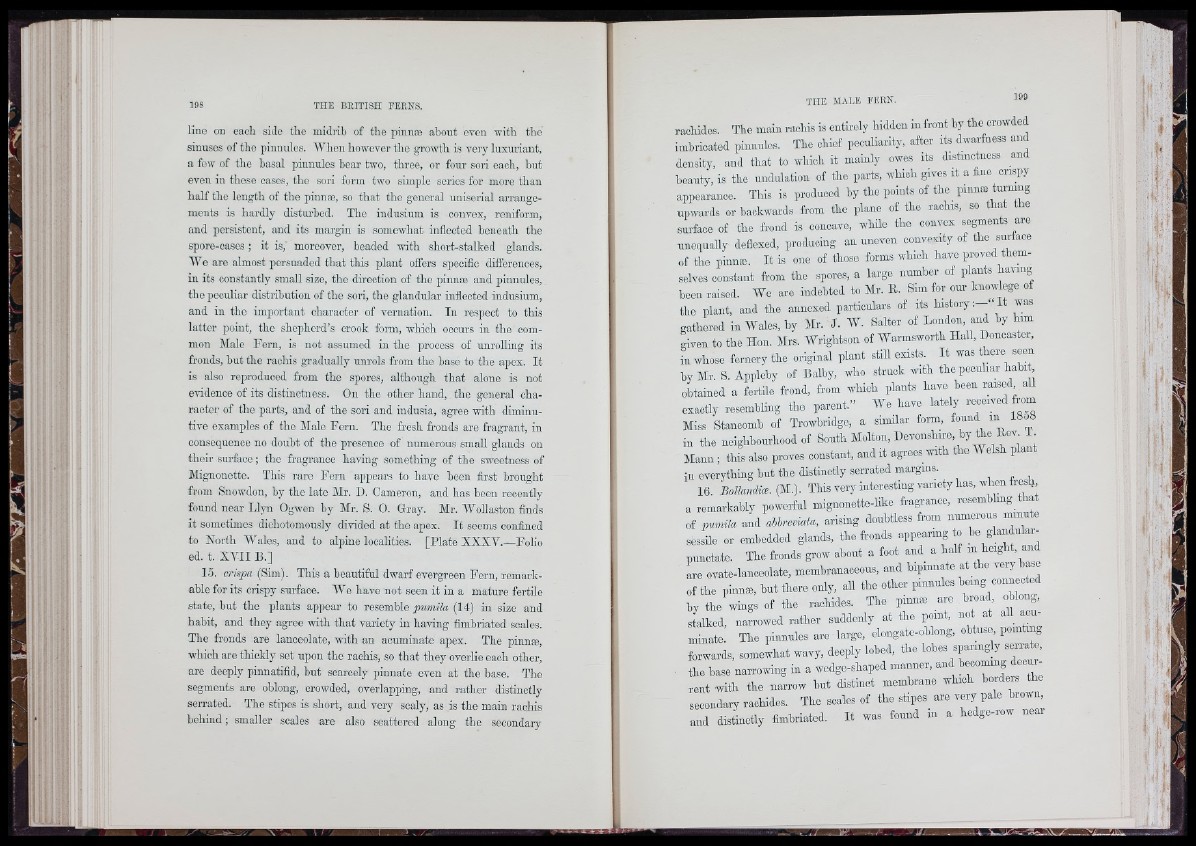
line on each side the midrib of the pinnæ about even with tho
sinuses of tho pinnules. IVheii however tho growth is very luxuriant,
a few of the basal pinnules bear two, three, or four sori each, hut
even iu these oases, the sori form two simple scries for more than
half the length of tho piunæ, so that the general unisorial arrangements
is hardly disturbed. Tbo indusium is convex, roniform,
and persistent, and its margin is somewhat inflected beneath the
spore-oases ; it is, moreover, beaded m th short-stalked glands.
IVe aro almost persuaded tbat this plant offers specific differences,
in its constantly small size, the direction of the pinnæ and pinnules,
the peculiar distribution of the sori, the glandular inflected indusium,
and in the important character of vernation. In respect to this
latter point, the shepherd’s crook form, which occurs in the common
Male Fern, is not assumed in tho process of unrolling its
fronds, but the raohis gradually unrols from the base to the apex. I t
is also reproduced from the spores, although that alone is not
evidence of its distinctness. On tho other hand, the general oharaoter
of tho parts, and of the sori and indusia, agree with diminutive
examples of the Male Fern. Tho fresh fronds are fragrant, in
consequence no doubt of the presence of numerous small glands on
thoir surface ; the fragrance haring something of tho sweetness of
Mignonette. This rare Fern appears to have boon first brought
from Snowdon, hy the late Mr. I). Cameron, and has been recently
found noar Llyn Ogwon by Mr. S. 0 . Gray. Mr. Wollaston finds
it sometimes dichotomously divided at the apex. I t seems confined
to North lYales, and to alpine localities. [Plate XXXV.—Folio
ed. t. X Y II B.]
15. crispa (Sim). This a beautiful dwarf evergreen Fern, remarkable
for its crispy surface. IVe have not seen it in a mature fertile
state, hut the plants appear to resemble pumila (14) in size and
hahit, and they agree with that variety in haring fimbriated scales.
The fronds are lanceolate, v ith an acuminate apex. Tho pinnæ,
which are thickly set upon the raohis, so that they overlie each other,
are deeply pinnatifid, but scarcely pinnate even at the base. The
segments are oblong, crowded, overlapping, and rather distinctly
serrated. The stipes is short, and very scaly, as is the main rachis
behind ; smaller scales are also scattered along the secondary
rachidos. The main raohis is entirely hidden in front by the crowded
imbricated pinnules. Tho chief peculiarity, after its dwarfaess and
density, and that to which it mainly owes its distinctness and
beauty, is the undulation of the parts, which gives it a fine crispy
appearance. This is produced hy the points of the pinnæ turning
upwards or backwards from the plane of tho raohis, so that the
surface of the frond is concave, while the convex segments are
unequally defiexed, producing an uneven convexity of the surface
of the pinnæ. I t is one of thoso forms which havo proved thom-
solvos constant from the spores, a large immhor of plants having
been raised. We are indebted to Mr. R. Sim for our knovdege of
the plant, and the annexed particulars of its history I t was
gathered in Wales, by Mr. J . W. Salter of London, and hy him
given to the Hon. Mrs. Wrightson of Warmsworth Hall, Doncaster,
in whose fernery the original plant still exists. I t was there seen
hy Mr. S. Appleby of Balby, who struck with the peculiar habi ,
obtained a fertile frond, from which plants have been raised all
exactly resembling tho parent.” We have lately received from
Miss Stanoomh of Trowbridge, a similar form, found m 1858
ill the neighb o u rh o o d of S ° ^ th Molton, D evonshire, by tire Eev Y
Mann ; this also proves constant, a u d it agrees with tho W elsh plant
in everything but t h e d i s t i n c t l y s e r r a t e d m a r g i n s .
16. Bollmuliæ. (M.). This very in te re s tin g v a rie ty h a s , when fresh
a remarkably powerful mignonette-like fragrance, resembling that
of pumila and aPbroeüMa, arising doubtless from immorous minute
sessile or embedded glands, the fronds appearing to
punctate. Tho fronds grow about a foot and a half m heig ,
are ovate-lanceolate, membranaceous, and bipinnate at the very base
of the pinnæ, hut there only, all the other pinnules
hy the wings of the rachides. The pmnæ are broaff oblong,
stalked, narrowed rather suddenly at the point, not at all acuminate.
Tho pinnules are large, olongato-ohlong, obtuso, pointing
forwards, s o m e ^ t wavy, deeply lohed, the lobes sparingly serrate,
the base narrowing in a wedge-shaped manner, an ^ eooming e i
rent irith the narrow but distinct membrane which borders the
secondary rachides. The scales of the stipes are very pale brown
and distinctly fimbriated. I t was found in a hedge-row neai